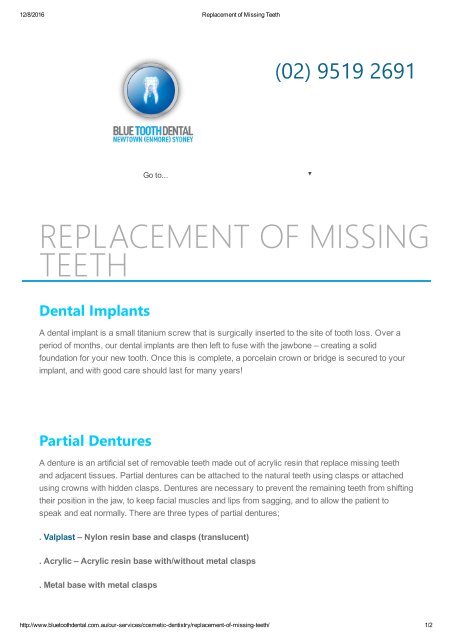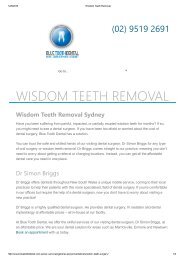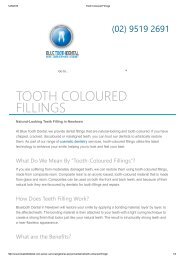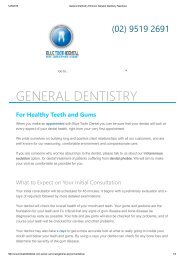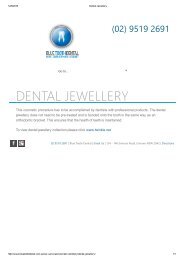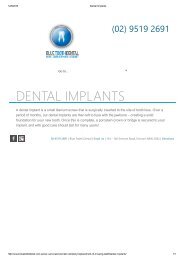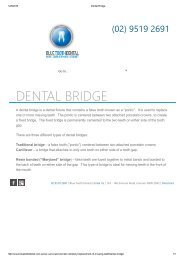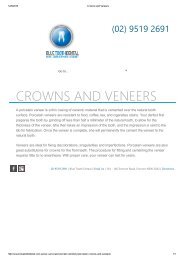Replacement of Missing Teeth
Create successful ePaper yourself
Turn your PDF publications into a flip-book with our unique Google optimized e-Paper software.
12/8/2016 <strong>Replacement</strong> <strong>of</strong> <strong>Missing</strong> <strong>Teeth</strong><br />
﴾02﴿ 9519 2691<br />
Go to...<br />
REPLACEMENT OF MISSING<br />
TEETH<br />
Dental Implants<br />
A dental implant is a small titanium screw that is surgically inserted to the site <strong>of</strong> tooth loss. Over a<br />
period <strong>of</strong> months, our dental implants are then left to fuse with the jawbone – creating a solid<br />
foundation for your new tooth. Once this is complete, a porcelain crown or bridge is secured to your<br />
implant, and with good care should last for many years!<br />
Partial Dentures<br />
A denture is an artificial set <strong>of</strong> removable teeth made out <strong>of</strong> acrylic resin that replace missing teeth<br />
and adjacent tissues. Partial dentures can be attached to the natural teeth using clasps or attached<br />
using crowns with hidden clasps. Dentures are necessary to prevent the remaining teeth from shifting<br />
their position in the jaw, to keep facial muscles and lips from sagging, and to allow the patient to<br />
speak and eat normally. There are three types <strong>of</strong> partial dentures;<br />
. Valplast – Nylon resin base and clasps (translucent)<br />
. Acrylic – Acrylic resin base with/without metal clasps<br />
. Metal base with metal clasps<br />
http://www.bluetoothdental.com.au/ourservices/cosmeticdentistry/replacement<strong>of</strong>missingteeth/ 1/2
12/8/2016 <strong>Replacement</strong> <strong>of</strong> <strong>Missing</strong> <strong>Teeth</strong><br />
Fabrication and proper fitting <strong>of</strong> dentures can take several dental visits. First, your dentist takes an<br />
impression <strong>of</strong> the gums along with a wax bite, in order to determine the vertical dimensions and<br />
proper jaw position for the denture. The dentist may make a trial denture or “tryin” to make sure <strong>of</strong> the<br />
shape, color and proper fit. Follow up visits for minor adjustments may be required to insure a perfect,<br />
comfortable fit.<br />
What is Valplast? It is a nylon thermoplastic material that has several advantages over the other two<br />
types <strong>of</strong> partial dentures. Valplast partial dentures have no metal clasps and are very light weight. The<br />
material is translucent, so the patient’s own gums show through, giving a very natural appearance.<br />
Valplast partial dentures can be used to replace many or few missing teeth, and can even be modified<br />
to replace a missing tooth on only one side <strong>of</strong> the mouth, greatly enhancing its comfort. Valplast can<br />
be used for full dentures on people who have irregularities in their jaw bone that would preclude the<br />
use <strong>of</strong> the standard rigid acrylic material. Valplast is an option for cosmetic improvement <strong>of</strong> teeth that<br />
appear elongated due to recession <strong>of</strong> the gums, and for people who are allergic to the acrylic found in<br />
other types <strong>of</strong> partial dentures. Another great advantage <strong>of</strong> Valplast is its resistance to breakage, as it<br />
is surprisingly strong relative its size and weight.<br />
Valplast partial dentures are an excellent option for the replacement <strong>of</strong> missing teeth. The cost <strong>of</strong><br />
treatment is usually much less than either a permanent bridge or dental implants and can be<br />
completed in just two or three short visits.<br />
They are not for people who smoke, smoking will stain them. They are hard to repair if anything goes<br />
wrong or you need to add a tooth. However many people love the feel <strong>of</strong> them.<br />
Dental Bridge<br />
A dental bridge is a dental fixture that contains a false tooth known as a “pontic”. It is used to replace<br />
one or more missing teeth. The pontic is centered between two attached porcelain crowns, to create<br />
a fixed bridge. The fixed bridge is permanently cemented to the two teeth on either side <strong>of</strong> the tooth<br />
gap.<br />
There are three different types <strong>of</strong> dental bridges:<br />
Traditional bridge – a false tooth (“pontic”) centered between two attached porcelain crowns<br />
Cantilever – a bridge that attaches to only one tooth on either side <strong>of</strong> a tooth gap.<br />
Resin bonded (“Maryland” bridge) – false teeth are fused together to metal bands and bonded to<br />
the back <strong>of</strong> teeth on either side <strong>of</strong> the gap. This type <strong>of</strong> bridge is ideal for missing teeth in the front <strong>of</strong><br />
the mouth.<br />
02 9519 2691 | Blue Tooth Dental | Email Us | 134 ‐ 146 Enmore Road, Enmore NSW 2042 | Directions<br />
http://www.bluetoothdental.com.au/ourservices/cosmeticdentistry/replacement<strong>of</strong>missingteeth/ 2/2


